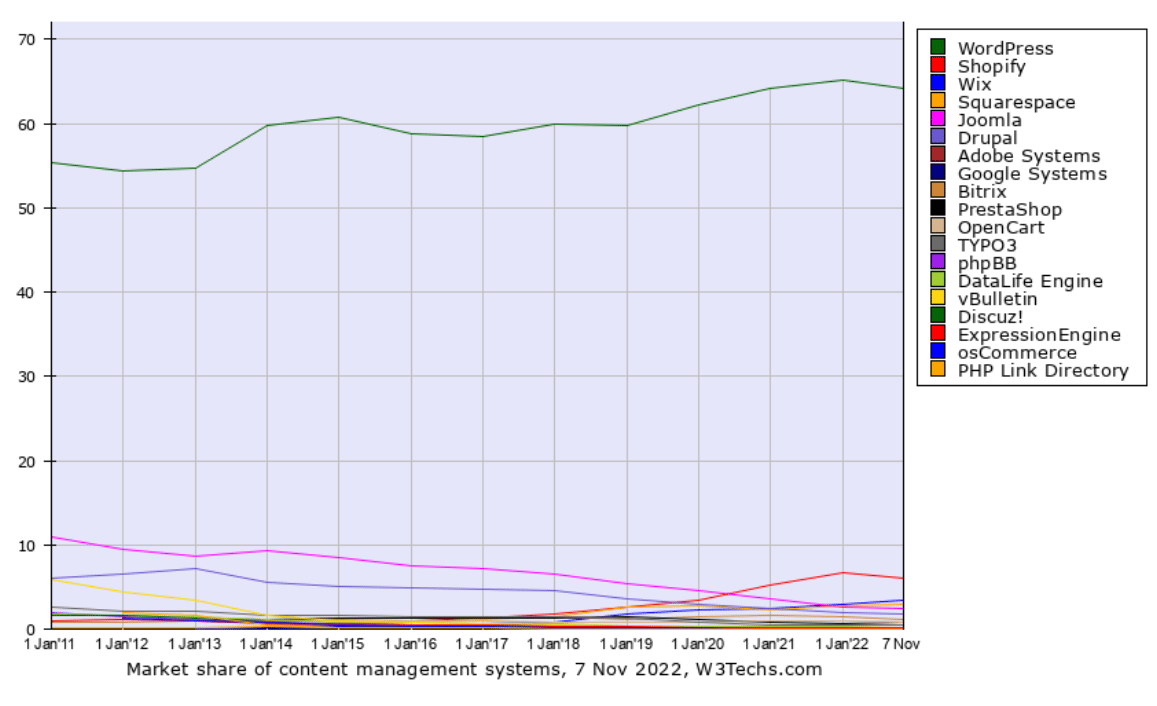CMS Market Share: What Is the Most Popular CMS 2025?
CMS (content management systems) are the backbone of the internet.
These software solutions power over two-thirds of all known websites. And they make it easy for users to create, manage, and modify website content without any coding knowledge.
In this post, we’ll explore the distribution of CMS market share and reveal which vendors dominate the market.
We’ll also take a closer look at the growth of individual CMS platforms to see how their market share has changed over time—and why.
Ready? Let’s get started!
What is the most popular CMS?
WordPress is by far the most popular CMS. It dominates the CMS market with a whopping 62.8% market share as of March 2025, and powers 43.2% of all websites.
WordPress has been the market leader for over a decade—no other CMS has ever come close. Shopify is its nearest competitor but ranks in an incredibly distant second place with just 6.1% of the CMS market share. That makes it 10x less popular than WordPress.
There are many reasons so many people choose to build their websites on WordPress. But one of the main reasons it’s so popular is because the core WordPress software is free and open-source.
That means that, unlike most other CMS solutions, anyone can build a site on WordPress without paying a subscription fee. Plus, it’s also incredibly flexible, fast, extensible, and developer-friendly.
Source: W3Techs1
Top CMS by market share
Now let’s take a closer look at the top content management systems in the world by their market share. But first, a few quick notes about the numbers:
We can use two data sources to analyze each CMS’s market share: W3Tech and BuiltWith.
W3Tech tracks the CMS used by the top 10 million websites according to Alexa, and the top 1 million websites according to Tranco, to limit the impact of domain spammers in the data set. And it excludes things like duplicate sites redirected domains and subdomains.
BuiltWith tracks the CMS used across the entire internet (roughly 80 million websites). This is a substantially larger dataset than W3Tech but may not provide as accurate a representation of each CMS’s ‘true’ market share as it may include ‘spam’ domains, subdomains, and duplicate domains.
We see W3Tech as the more accurate data source of the two, so let’s start there.
CMS market share (W3Tech)
Here’s a breakdown of the top 10 CMS by market share as of November 2022, according to W3Tech.
| Rank | CMS | CMS market share | Website share* |
| #1 | WordPress | 62.8% | 43.2% |
| #2 | Shopify | 6.1% | 4.1% |
| #3 | Wix | 3.4% | 2.3% |
| #4 | Squarespace | 2.9% | 2% |
| #5 | Joomla | 2.4% | 1.6% |
| #6 | Drupal | 1.8% | 1.2% |
| #7 | Adobe Systems | 1.6% | 1.1% |
| #8 | Google Systems | 1.3% | 0.9% |
| #9 | Bitrix | 1.1% | 0.8% |
| #10 | Webflow | 0.9% | 0.6% |
*Website share represents the % of all the websites W3Tech tracks that the CMS is used on. This is different from the CMS market share as it factors in the 32.9% of websites that use none of the content management systems W3Tech monitors, whereas CMS market share doesn’t.
There are a few interesting extrapolations we can make here.
First off, while WordPress (an open-source platform) is the clear market leader, the next three most popular CMS solutions are Shopify, Wix, and Squarespace. All of these are fully hosted, subscription-based platforms (i.e., not open-source).
Joomla (rank 5) and Drupal (rank 6) are open-source platforms like WordPress. But as we’ll see, the market share of both of these platforms has been falling steadily over the last decade, while WordPress has been growing.

This isn’t the case for the hosted platforms, all of which have grown their market share over the last few years.
This suggests that the products that are most successfully competing with WordPress are hosted CMS solutions, which are able to differentiate their product by offering additional benefits such as website maintenance, web hosting, etc. But in the open-source market, there’s little room for competition.
CMS market share (BuiltWith)
Here’s an overview of the top CMS by market share according to BuiltWith*:
| Rank | CMS | Market share | Websites |
| #1 | WordPress | 46% | 35.87 million |
| #2 | Other | 38% | N/A |
| #3 | Wix | 11% | 8.2 million |
| #4 | Squarespace | 4% | 3.14 million |
| #5 | Google Search Appliance | 2.7% | 1.9 million |
| #6 | GoDaddy Website Builder | 2.6% | 1.85 million |
| #7 | Plesk | 2.05% | 1.5 million |
| #8 | CPanel | 2% | 1.4 million |
| #9 | Joomla | 1.4% | 1 million |
| #10 | Duda | 1.32% | 0.95 million |
| #11 | Weebly | 1.1% | 0.83 million |
As you can see, WordPress is still the clear market leader with 45% market share. 37% of websites use a CMS not known by BuiltWith (this may include websites that use no CMS and are built from scratch).
But it’s important to point out that there are a few anomalies in this data set. First off, Progress Sitefinity ranks fourth according to BuiltWith, which is surprising given it didn’t rank in the top ten CMS in W3Tech’s data set (and in fact, may not have been considered at all).
But more notably, there are a few rankings here that aren’t true CMS software at all.
For example, CPanel (rank 8) is a GUI and control panel software—not a full-fledged content management system that can be used to build and manage a website.
Likewise, Google Search Appliance (rank 5) is a server-related hardware appliance, not a CMS. BuiltWith’s algorithm nonetheless picked both of these up and have skewed the results somewhat.
Interestingly, CMS market share also changes if we zoom in on high-traffic sites, as shown below.
CMS market share in the top 1 million websites:
| CMS | Market share |
| Other | 54% |
| WordPress | 32% |
| cPanel | 4% |
| Drupal | 3% |
| Google Search Appliance | 3% |
| My Salesforce | 3% |
CMS market share in the top 100k websites:
| CMS | Market share |
| Other | 68% |
| WordPress | 18% |
| My Salesforce | 5% |
| Atlassian Cloud | 4% |
| Drupal | 4% |
CMS market share in the top 10k websites:
| CMS | Market share |
| Other | 71% |
| WordPress | 12% |
| My Salesforce | 6% |
| Atlassian Cloud | 6% |
| Drupal | 4% |
This suggests that the more traffic a website gets, the less likely it is to use WordPress in favor of enterprise-grade software like Salesforce, or ‘Other’ CMS. The high usage of CMS categorized as ‘Other’ may be because large enterprises are more likely to use custom-built solutions.
Source: W3Tech1, W3Tech2, BuiltWith1
CMS market share: A closer look
Next, let’s zoom in on some of the most popular CMS and look at how their market share has evolved over time.
WordPress market share
WordPress is the undisputed market leader. It’s an open-source solution with a huge library of themes and plugins that make it very flexible and versatile.
Thanks to its strong SEO capabilities, WordPress is particularly popular amongst bloggers and content-driven websites. And because it’s self-hosted, you retain 100% control and ownership of your website content.
For all these reasons and more, it’s remained the most popular CMS in the world for over a decade. Here’s how WordPress’s market share has evolved over that time:
| Year | Market share |
| 2024 | 62.8% |
| 2023 | 63.5% |
| 2022 | 64.2% |
| 2021 | 64.1% |
| 2020 | 62.1% |
| 2019 | 59.7% |
| 2018 | 60% |
| 2017 | 58.5% |
| 2016 | 58.8% |
| 2015 | 60.7% |
| 2014 | 59.8% |
| 2013 | 54.8% |
| 2012 | 54.3% |
| 2011 | 55.3% |
You can see from these stats that WordPress has had a very consistent growth trajectory. The CMS has slowly and steadily increased its market share over time, with the biggest increase coming between 2013 and 2014.

However, we can also see that WordPress only increased its market share by 0.1% from Jan 2021 to March 2025, which suggests it may now be stabilizing.
Shopify market share
Shopify is a fully hosted eCommerce platform. It’s WordPress’s biggest competitor with the second largest market share, but it focuses on a different market segment.
While WordPress is a general-purpose CMS, Shopify is built specifically for commerce and comes with everything you need to build an online store. It’s the number one hosted ecommerce solution by market share.
Here’s how Shopify’s CMS market share has changed over time:
| Year | Market share |
| 2024 | 6.2% |
| 2023 | 6.1% |
| 2022 | 6.0% |
| 2021 | 5.2% |
| 2020 | 3.4% |
| 2019 | 2.6% |
| 2018 | 1.8% |
| 2017 | 1.3% |
| 2016 | 1% |
| 2015 | 0.7% |
| 2014 | 0.3% |
As you can see, Shopify has experienced meteoric growth since its inception in 2014. While WordPress has grown steadily, Shopify has grown extraordinarily quickly, increasing its market share by over 1900% in just 8 years.
We have also covered other Shopify statistics in more detail.
Wix market share
Wix is a popular, fully-hosted website builder. It’s the third most popular CMS by market share and, like Shopify, has grown incredibly quickly over the last few years.
Here’s a breakdown of Wix market share over time:
| Year | Market share |
| 2024 | 3.8% |
| 2023 | 3.6% |
| 2022 | 3.4% |
| 2021 | 2.4% |
| 2020 | 2.3% |
| 2019 | 1.8% |
| 2018 | 0.9% |
| 2017 | 0.6% |
| 2016 | 0.4% |
| 2015 | 0.3% |
| 2014 | 0.2% |
| 2013 | <0.1% |
Wix has increased its market share for 10 consecutive years in a row, but the biggest jumps came between 2018 and 2019, and again between 2021 and 2022.
For further reading, we recommend having a look into in-depth Wix statistics.
Squarespace market share
Squarespace is another general-purpose, hosted website-building platform known for its ease of use, excellent design tools, and stellar templates. It’s the fourth most popular CMs by market share and has grown its user base substantially over the last decade.
Here’s a table that shows Squarespace’s market share over time:
| Year | Market share |
| 2024 | 3.0% |
| 2023 | 3.0% |
| 2022 | 2.9% |
| 2021 | 2.3% |
| 2020 | 2.7% |
| 2019 | 2.6% |
| 2018 | 1.5% |
| 2017 | 1.1% |
| 2016 | 0.8% |
| 2015 | 0.5% |
| 2014 | 0.3% |
| 2013 | 0.1% |
| 2012 | 0.2% |
| 2011 | 0.2% |
Again, Squarespace has increased its market share pretty consistently. The exception to this was from 2020 to 2021, when the market share dropped from 2.7% to 2.3%.
If you are considering this, here you can find in-dept Squarespace statistics to understand if that’s the right platform for your project.
Joomla market share
Joomla is the second most popular open-source CMS, with 2.4% of the market share. But it’s much, much less well-known than WordPress. And as the chart below shows, it’s only grown less popular over time:
| Year | Market share |
| 2024 | 2.5% |
| 2023 | 2.5% |
| 2022 | 2.4% |
| 2021 | 3.6% |
| 2020 | 4.6% |
| 2019 | 5.4% |
| 2018 | 6.5% |
| 2017 | 7.2% |
| 2016 | 7.5% |
| 2015 | 8.6% |
| 2014 | 9.3% |
| 2013 | 8.7% |
| 2012 | 9.5% |
| 2011 | 10.9% |
Joomla reached its peak early. As one of the first CMS solutions to hit the market, its heyday was back in 2011, when it had a market share of 10.9%. Since then, it’s been slowly losing market share to WordPress and has shrunk to just 2.4% market share as of November 2022.
Drupal market share
Drupal is another open-source CMS that could be considered a dying platform. Like Joomla, it’s steadily lost market share over the years.
While it had a good few years from 2011 to 2013, its numbers have been falling since then and reached their lowest point this year at just 1.8% market share:
| Year | Market share |
| 2024 | 1.5% |
| 2023 | 1.7% |
| 2022 | 1.8% |
| 2021 | 2.5% |
| 2020 | 3% |
| 2019 | 3.5% |
| 2018 | 4.6% |
| 2017 | 4.8% |
| 2016 | 4.9% |
| 2015 | 5.1% |
| 2014 | 5.5% |
| 2013 | 7.2% |
| 2012 | 6.5% |
| 2011 | 6.1% |
Source: W3Tech1
Final thoughts
That concludes our in-depth guide to CMS market share. We hope you found these statistics useful!
As we’ve seen, WordPress continues to be the most popular CMS on the market—by a huge margin. It’s extended its lead over the last decade and now holds almost two-thirds of the CMS market share.
Likewise, Shopify, Wix, and Squarespace have grown rapidly and are now big players in the space.
But Drupal and Joomla are the biggest losers, having lost over two-thirds of their market share since 2011.
If you want to learn more about the number one CMS, you might want to check out our roundup of WordPress statistics.
Good luck!







Comments (0)